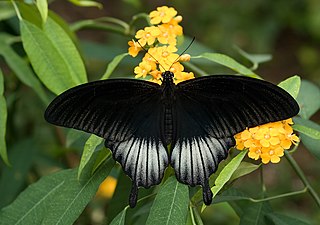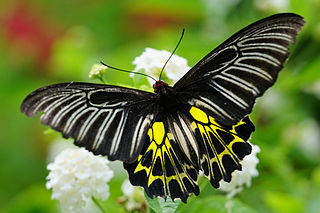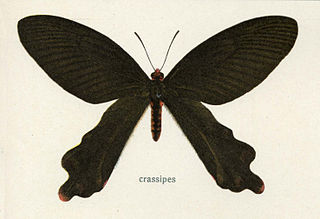
Atrophaneura Hector, the crimson rose, is a large swallowtail butterfly belonging to the genus Pachliopta (roses) of the red-bodied swallowtails. It is recorded as a species of "Least Concern (LC)" by IUCN.

Papilio memnon, the great Mormon, is a large butterfly native to southern Asia that belongs to the swallowtail family. It is widely distributed and has thirteen subspecies. The female is polymorphic and with mimetic forms.

Pachliopta aristolochiae, the common rose, is a species of swallowtail butterfly belonging to the genus Pachliopta, the roses, or red-bodied swallowtails. It is a common butterfly which is extensively distributed across south and southeast Asia.

Papilio paris, the Paris peacock swallowtail, is a species of swallowtail butterfly found in the Indian subcontinent and southeast Asia.

Papilio alcmenor, the redbreast, is a species of swallowtail butterfly found in South Asia.

Papilio nephelus is a species of swallowtail butterfly belonging to the family Papilionidae. Subspecies include P. n. chaon, the yellow Helen, and P. n. sunatus, the black and white Helen.

Troides aeacus, the golden birdwing, is a large tropical butterfly belonging to the swallowtail family, Papilionidae.

Troides helena, the common birdwing, is a butterfly belonging to the family Papilionidae. It is often found in the wildlife trade due to its popularity with butterfly collectors. The butterfly has seventeen subspecies.

Meandrusa sciron, the brown gorgon, is a species of swallowtail butterfly found in parts of South Asia and Southeast Asia. It belongs to the hooked swallowtails genus, Meandrusa, of the family Papilionidae. The brown gorgon is found in India from Sikkim to Assam and north Burma and is not considered to be threatened. Though not uncommon, it is protected under Indian law under the name gyas.

Losaria coon, the common clubtail, is a butterfly belonging to the swallowtail family, Papilionidae. The butterfly belongs to the clubtails, genus Losaria. It includes several subspecies and is found from the Nicobar Islands and Assam in India, east to Hainan in China, and south through Indochina, to Java and other islands of Indonesia and Bangladesh.

Papilio (Chilasa) agestor, the tawny mime, is a swallowtail butterfly, native to Indian subcontinent and widely found across Asia. The butterfly belongs to the mime subgenus, Chilasa, of the genus Papilio or the black-bodied swallowtails.

Papilio (Chilasa) epycides, the lesser mime, is a swallowtail butterfly found in India and parts of South-East Asia. The butterfly belongs to the mime (Chilasa) subgenus or the black-bodied swallowtails. It is a mimic of a common Indian Danainae, the glassy tiger butterfly.

Papilio (Chilasa) paradoxa, the great blue mime, is a swallowtail butterfly found in India and parts of South-East Asia. The butterfly belongs to the mime subgenus, Chilasa, of the genus Papilio. It is an excellent mimic of different species of Euploea.

Papilio (Chilasa) slateri, the blue striped mime, is a swallowtail butterfly found across south and south-east Asia. The butterfly belongs to the mime subgenus, Chilasa, of the genus Papilio, the black-bodied swallowtails. The nominate subspecies is found in India and is also called the brown mime. It is a good example of mimicry among Indian butterflies.

Graphium eurypylus, the great jay or pale green triangle, is a species of tropical butterfly belonging to the family Papilionidae.

Byasa latreillei, the rose windmill, is a butterfly from the windmills genus (Byasa), found in various parts of Asia, comprising tailed black swallowtail butterflies with white spots and red submarginal crescents.

Atrophaneura aidoneus, the lesser batwing, is an Asian species of butterfly that belongs to the batwings group of Atrophaneura, comprising tailless black swallowtail butterflies.

Byasa crassipes, the black windmill, is a butterfly found in India and Southeast Asia that belongs to the windmills genus, Byasa, comprising tailed black swallowtail butterflies with white spots and red submarginal crescents.

Parnassius jacquemontii, the keeled Apollo, is a high altitude butterfly which is found in India and Pakistan. It is a member of the snow Apollo genus (Parnassius) of the swallowtail family (Papilionidae). It is also fairly common at high altitudes from Chitral to Kumaon.

Atrophaneura priapus, the Priapus batwing or white-head batwing, is a swallowtail butterfly found in Burma, Malaysia, Sumatra, and Java. The subspecies A. p. hageni was named to honour Hermann August Hagen. It may be a full species.




















